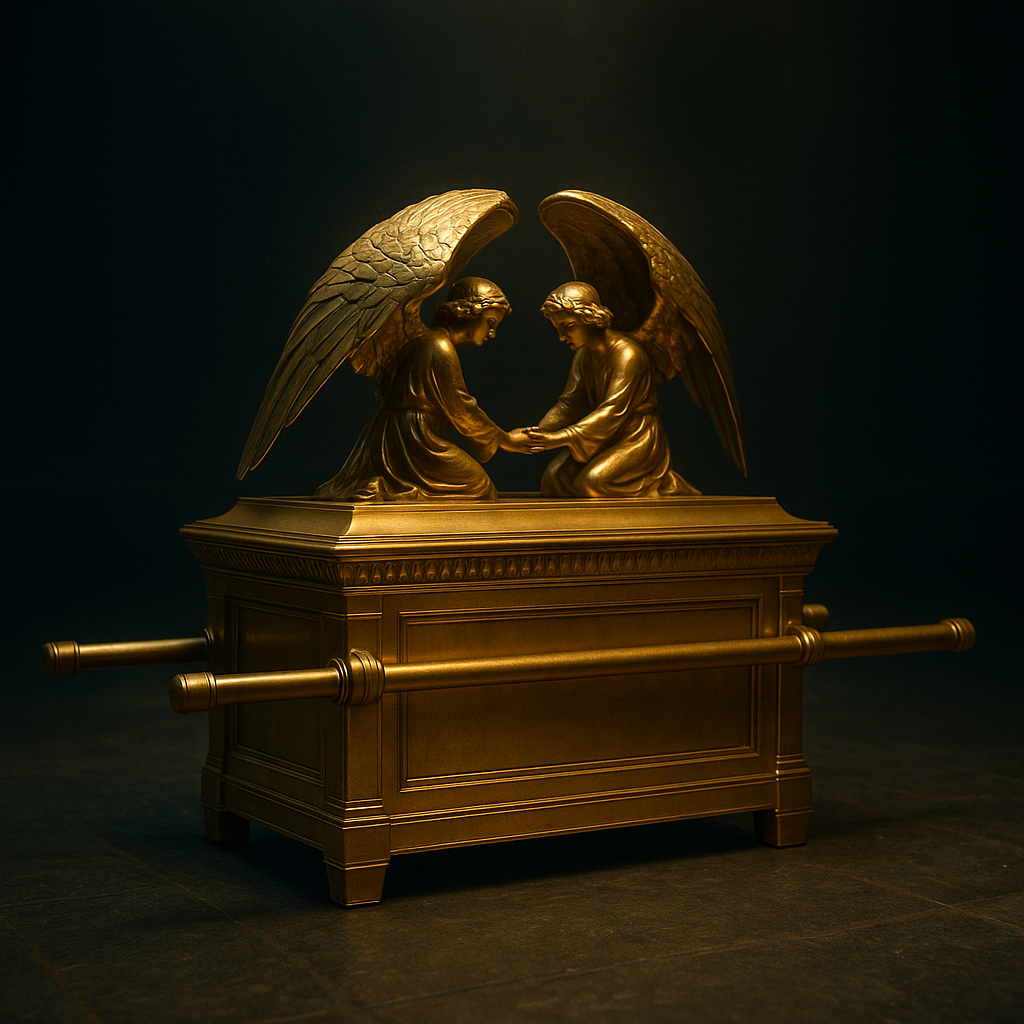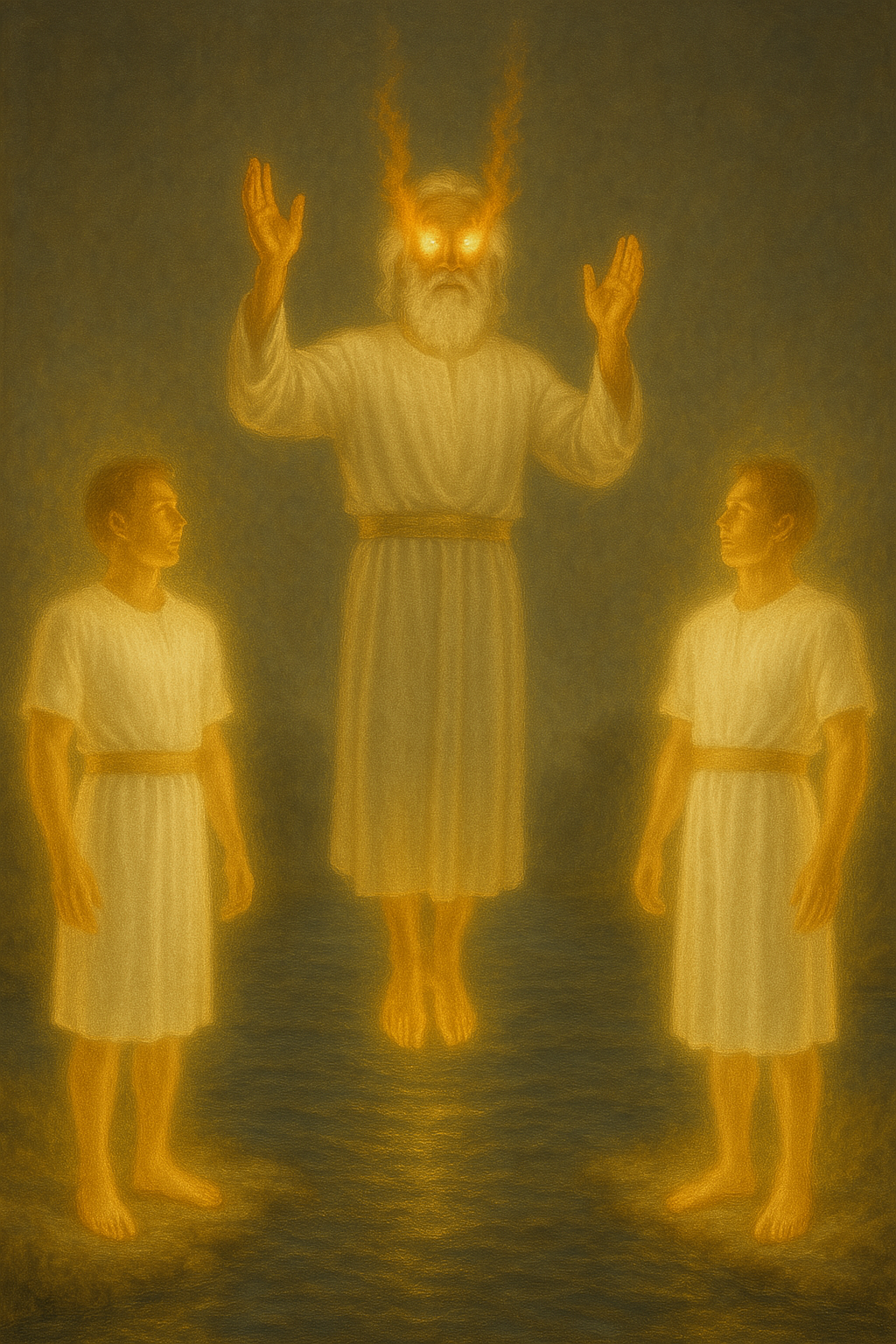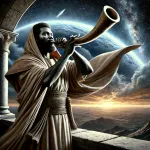Gabriel and Michael

The two anointed ones who stand by the Lord of the whole earth...
Introduction: A retrieval, not a novelty
This essay advances a careful retrieval: Michael and Gabriel function as the pre-eminent pair who “stand before” the Lord, a pairing that helps illuminate the two cherubic figures over the mercy-seat and many “two-angel” scenes across Scripture.
The Jewish and Second-Temple backdrop
Early Christian angelology did not arise in a vacuum. Within Jewish tradition, Michael and Gabriel are habitually paired—often imagined as right and left attendants before the Divine Presence. At the same time, Second-Temple literature widens the court around God’s throne. Tobit speaks of “one of the seven angels who stand and enter before the glory of the Lord,” and 1 Enoch portrays four “presence” angels—Michael, Gabriel, Raphael, and Phanuel—who stand before the Lord of Spirits. The right/left pairing of Michael and Gabriel is therefore real and influential, without implying exclusivity.
The apostolic witness
The New Testament gives both angels marked prominence. Gabriel identifies himself to Zechariah as “the one who stands in the presence of God,” grounding his earthly mission in a continuing heavenly status. Jude names “Michael the archangel” in his conflict with the devil, a uniquely honorific designation. Yet Revelation also acknowledges a broader cadre—“the seven angels who stand before God.” Taken together, these texts justify viewing Michael and Gabriel as foremost among those who stand, while recognizing that others also share proximity to the throne.
How the Fathers typically read Zechariah 4 and Revelation 11
The patristic baseline matters. In commenting on Zechariah 4, the mainstream early Christian reading identifies the “two sons of oil” with Joshua the high priest and Zerubbabel the governor—the priestly and royal offices that together “feed” the single lampstand—rather than with two archangels. Likewise, in Revelation 11 many early commentators favored Enoch and Elijah (or Moses and Elijah) as the Two Witnesses. A responsible retrieval therefore acknowledges that a direct, explicit “Michael & Gabriel = Zech 4 / Rev 11” equation is not the patristic consensus in the texts that survive. However my view is that Zechariah is indeed speaking about the two witnesses which is why John uses that reference.
The hermeneutical bridge: standing, cherubim, and the grammar of “two”
Even so, Scripture’s persistent “two-angel” pattern invites a deeper synthesis. The mercy-seat is flanked by two cherubim; Abraham receives the Lord with two accompanying messengers; two angels appear at the empty tomb and again at the ascension; the law is established by “two witnesses.” Within this biblical grammar of twoness, the pre-eminence and complementary roles of Michael (protector, warrior) and Gabriel (herald, interpreter) commend them as the archetypal right-and-left ministers who stand before God and are sent on decisive errands of judgment and mercy.
This reading does not deny the immediate historical sense of Zechariah 4 (Joshua and Zerubbabel). It proposes that, behind those historical and prophetic embodiments, there is a stable heavenly pattern: two standing ministers whose service is mirrored in earthly witnesses and priest-king pairings. In this way the typology is cumulative rather than competitive.
A disciplined synthesis
Read this way, the thread holds together without overclaiming. Jewish devotion frequently pairs Michael and Gabriel as nearest to the divine Majesty. The New Testament singles them out by name and office while acknowledging a wider circle of “stand-before” angels. Early Christian piety often venerates them together as chief ministers, even if exegetes commonly read Zechariah 4 in priest-king terms and Revelation 11 as human prophets. The result is a measured thesis: Michael and Gabriel are the heavenly prototype of the paired witness—right and left at the mercy-seat, foremost among the servants who stand, and fitting candidates to underwrite Scripture’s recurring “two-angel” scenes.
Two clarifications keep the proposal disciplined. First, Revelation elsewhere uses “lampstands” as a symbol for covenant communities; taking the lampstand imagery of Revelation 11 as exceptionally applied to a heavenly mission-pair must be stated, not assumed--however Zechariah provides reference here. Second, if one argues that the witnesses of Revelation 11 are literally Michael and Gabriel, one must also explain how they can truly suffer and die; the most coherent account is that, for a fixed term of testimony, they accept a mission that includes real human vulnerability, and so their death and resurrection accord with the plain sense of the text. Which would explain their wearing sackcloth versus glorious white. Others will prefer to keep the identification at the level of archetype and earthly embodiment rather than strict identity. Either way, the typology remains intact.
Why this matters now
Within the eschatological framework I've presented, the retrieval is not merely academic. If God often acts “by two,” and if Michael and Gabriel stand as the premier pair before His throne (named in both Canons), then the pattern behind Zechariah 4 and Revelation 11 clarifies what sort of witness God sends before judgment and why their testimony carries such weight. I hold that the world stands at the threshold of such a season. Whether one understands the two witnesses as the angelic pair assuming mortal commission or as earthly agents embodying their heavenly pattern, the pastoral implication is the same: a final, authoritative call to repentance precedes wrath, borne by those who stand nearest to the Majesty and speak with His delegated authority.

I've now written about Gabriel and Michael several times, and you may be asking why? Well--they are the two witnesses and their ministry of 1260 days will start next year October. It's important to establish their identity ahead of time so as to support by way of scriptural testimony BEFORE their ministry that the two witnesses are who they say they are. The time of their ministry is at hand--and that is because the time of the end is at hand. Their 1260 days of testimony will be the last reprieve given for repentance; after their ministry ends--the time of wrath commences. The fact that the Lord of all the earth--Jesus Christ--the Word of YHWH himself sends his senior two most angels to the earth to testify before the time of wrath--says everything about how serious this moment is. These are the two angels who sent fire down upon Sodom. They are the ones who visited Abraham with YHWH at Mamre; they are the ones who appeared to Daniel with YHWH--twice! They are the ones referred to by Zechariah in chapter 4, they were there at the resurrection, and also at the ascension--and indeed at the ascension confirmed Jesus return to the Mount of Olives to fulfil Zechariah's prophecy in chapter 14:4. In Revelation 11, after the resurrection of the two witnesses--they are caught up to heaven; and after this the ark of the covenant in heaven is seen. They return to where they came from; the presence of God--taking their positions as the cherubim of witness covering the ark of testimony!
Conclusion: An Ancient and Apostolic Teaching
The evidence presented demonstrates that the identification of Gabriel and Michael as the two anointed ones of Zechariah 4:14, the cherubim of the Ark, and the perpetual divine ministers appearing throughout Scripture, represents not a novel interpretation but the recovery of an ancient understanding. This teaching, rooted in pre-Christian Jewish tradition, confirmed by apostolic practice, developed by the fathers, preserved in the liturgies, and maintained especially in the Eastern churches, provides a consistent hermeneutical key for understanding the ministry of angels throughout salvation history.
When modern readers recognize Gabriel and Michael in these roles, they stand not as innovators but as inheritors of a tradition reaching back to the apostles themselves. The simplicity of this understanding—two named angels who consistently appear at crucial moments—reflects not primitive angelology but rather the elegant simplicity of divine order, where two witnesses establish every matter, and two anointed ones perpetually stand before the Lord of all the earth.
This ancient recognition enriches our understanding of Scripture's unity, showing how from Genesis to Revelation, the same God works through the same primary ministers, maintaining consistent order in the execution of His divine will. The fathers saw what patient reading of Scripture reveals: not a confusion of anonymous angels, but the orderly ministry of Gabriel and Michael, the two anointed ones who stand by the Lord of all the earth.
This testimony of their identity has ancient roots. Whilst most people are expecting Elijah and Enoch, or possibly Elijah and Moses; the reality is Jesus already said "Elijah who is to come" per Malachi 4:5-6 already did come; and that was Jesus. This makes clear that there is no Elijah figure coming. Furthermore there is no reference in the entire Canon of Enoch returning. Additionally--if Elijah per Malachi was fulfilled by John the Baptist by way of taking on his mantle and ministry and therefore fulfilling the prophecy; it suggests definitively that once a person is taken from the earth either in death or by translation--their time here is done; with only resurrection, judgement or eternal inheritance remaining. This establishes that Moses is not returning to die a second time 3500 years after his ministry; and neither are Enoch or Elijah. This establishes that the two witnesses are not two prior prophets. So who are they? John the Revelator directly references Zechariah 4:14--both references speak about the two witnesses in the present tense, not future tense--telling us that they were in fact alive and operating in those functions when the prophecies were given. Daniel 8 and Daniel 10-12 show us the two witnesses in operation as does Genesis 18; Moses showed us how they are witnesses (they witness the glory of YHWH and the covenant/testimony/law of God) and what their rank is (Cherubim). It is thus fitting that the entire triad of people who appeared to Daniel in chapter 8 and 10-12 would come into the world--first and foremost, Jesus the Son of God who died and resurrected; and then next year at the end of age--Gabriel and Michael who will also be killed in Jerusalem like their Lord who is our Lord.
This is who God is sending to the world next year. The count down is on.
To God be the glory. Come Lord Jesus, come!


Comments ()